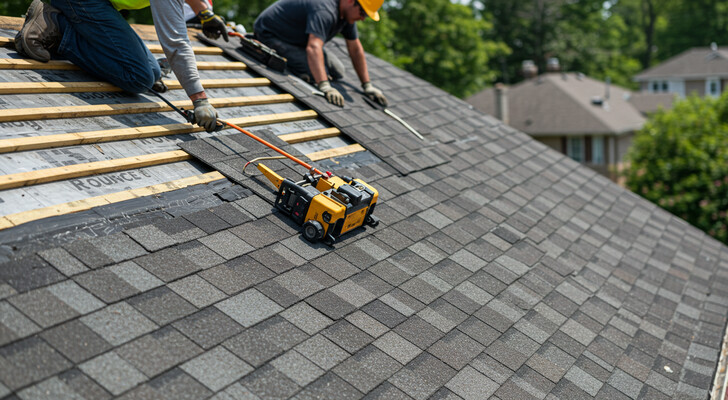
Replacing a roof is not only a major home improvement project but also a significant investment that requires careful planning. The roof protects your home from the elements, keeps energy costs in check, and maintains the structural integrity of the property. For a 1500 square foot home, homeowners need to consider the cost implications and understand the different elements that go into pricing. A new roof can enhance curb appeal, increase home resale value, and prevent future costly repairs due to water or storm damage. It is important to assess both the upfront cost and the long-term benefits of a roof replacement. Homeowners should also research contractors and materials in advance to ensure the best return on their investment.
Average Cost of a New Roof for a 1500 Square Foot Home
For a standard 1500 square foot home, the cost of a new roof typically ranges between $6,000 and $12,000, though prices can exceed this range for premium materials or complex roof designs. This estimate usually includes removing the old roof, installing underlayment, and placing the new roofing materials. The wide price range comes from variations in materials, labor rates, and regional differences in the cost of living. Asphalt shingles remain the most popular and affordable choice, but homeowners who prefer premium materials like metal, slate, or tile should be prepared to spend more. It is also worth noting that any additional repairs needed for decking or ventilation can add to the final bill.
Being aware of these potential costs helps avoid surprises during the project.
Factors That Influence Roofing Costs
Several factors can drive the cost of a roof replacement up or down. The type of roofing material is the biggest contributor, with asphalt shingles being the most budget-friendly and slate or clay tiles at the premium end. The roof’s pitch or steepness matters because steeper roofs are more dangerous to work on and often require more time and safety measures, which increases labor charges. The complexity of your roof’s design also plays a role, as roofs with multiple valleys, dormers, or chimneys require additional labor and materials. Removing multiple layers of old shingles can increase disposal costs, while rotten or damaged decking may require repairs before installation.
Local labor rates and building permit requirements vary by region and can add hundreds or even thousands of dollars to the overall project. Weather conditions and the time of year can also influence contractor availability and pricing.
Cost Comparison of Different Roofing Materials
Choosing the right roofing material is crucial for balancing upfront costs with long-term performance. Asphalt shingles cost around $3 to $5 per square foot installed and typically last 15 to 30 years depending on quality. Metal roofing costs $7 to $14 per square foot but can last 40 to 70 years and may reduce energy bills due to its reflective properties. Tile and slate roofs, while expensive at $15 to $30 per square foot, can last a century with proper maintenance and add a premium aesthetic appeal. Wood shingles or shakes fall in the mid-range but require more maintenance and are not ideal for all climates. When comparing materials, consider durability, warranty coverage, maintenance requirements, and how the roofing complements your home’s style. Energy-efficient or impact-resistant options may cost more initially but can lead to insurance discounts and long-term savings.
Ways to Save on Your Roof Replacement
While roof replacements are costly, there are several strategies to reduce the financial burden. Always get at least three quotes from licensed and insured contractors to compare pricing and avoid overpaying. Scheduling the project during off-peak times, such as late winter or early spring, can sometimes lead to discounted labor rates as contractors have fewer bookings. If your roof was damaged by storms or other covered events, check if your homeowner’s insurance can offset part of the cost. Consider using quality mid-range materials that offer a good balance of cost and durability instead of the cheapest option, which might wear out faster. You can also save by handling minor tasks like debris removal yourself if safe to do so, or by financing the project through a contractor or home improvement loan to spread out payments.
Maintaining your roof regularly with inspections and minor repairs helps extend its life and delays the need for full replacement.
Is a New Roof Worth the Investment
A new roof provides multiple benefits beyond just keeping your home dry. For homeowners planning to sell, a new roof often increases the property’s curb appeal and can attract more buyers, potentially speeding up the sale. Many buyers prefer a home with a recently replaced roof to avoid future expenses, making it a selling point during negotiations. A roof replacement can yield an average return on investment of 60% or more, depending on the material and housing market conditions. Beyond financial gains, a new roof improves insulation, energy efficiency, and indoor comfort, reducing heating and cooling costs. It also protects against water leaks, mold growth, and structural deterioration, ensuring your home remains safe and livable. In most cases, the peace of mind and added value outweigh the upfront cost.
Conclusion
The cost of a new roof for a 1500 square foot house depends on multiple factors, including material selection, labor rates, roof complexity, and regional pricing. On average, homeowners can expect to spend between $6,000 and $12,000, with higher-end materials and complex installations costing more. By comparing contractor quotes, choosing the right materials for your climate and budget, and exploring insurance or financing options, you can achieve the best balance between cost and quality. A well-installed roof provides years of protection, improved home value, and energy efficiency. Investing in a durable and properly installed roof is one of the smartest upgrades you can make for your home’s long-term health and resale potential.
